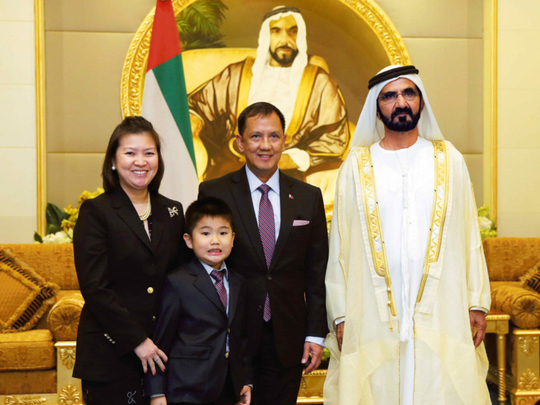
Trade figures between the UAE and the Philippines are projected to fall by about 22.97 per cent this year, in part due to lower oil prices, but the Philippines’ top envoy to the UAE is optimistic about the new presidential administration presenting new options to bolster the relationship between the two nations.
“With a new Philippine President comes opportunities to strengthen ties and explore more avenues for cooperation between the UAE and the Philippines,” said Constancio R. Vingno Jr., Ambassador of the Philippines to the UAE, ahead of the country’s Independence Day celebrations here.
The Philippines is preparing a low-key inauguration ceremony for president-elect Rodrigo Duterte later this month, and Vingno “can only foresee improvement in bilateral relations”.
Philippine exports to the UAE grew at an average annual rate of 8.4 per cent annually between 2011 and 2015, and amounted to $301.27 million (about Dh1.1 billion) last year, embassy data shows. Computer input or output units registered as the top product, accounting for 15.04 per cent of the total. Imports stood at $474.65 million, with petroleum oils and oils obtained from bituminous minerals (other than crude) making up 77.3 per cent.
Total trade for 2016 is estimated to reach about $616 million, down from $775.92 million.
“Food, both processed and fresh; health and wellness products, including beauty products; furniture and furnishings; and electronics and semi-conductors are some of the sectors identified with high potential for growth,” Vingno said.
600,000 OFWs
The UAE is the Philippines’ second-largest trading partner in the Middle East, and more than 600,000 Overseas Filipino Workers (OFWs) call the UAE home, second only to Saudi Arabia on both fronts. “The sheer number of Filipinos which we need to cater to here in the UAE is a challenge given the limited human resources of the embassy and consulate, but I also see this as a big opportunity,” said the ambassador.
“The Filipinos in the UAE are agents of change. Already, many of them have become investors in their communities back in the Philippines and some have also become philanthropists.”
Formal diplomatic ties between the two nations date back to 1980, with continued engagement in various fields including political, economic, cultural and labour dimensions. The first political consultations between the two foreign ministries should happen by the end of the year as part of the implementation of an agreement on political consultations signed in September 2013. An agreement on cooperation on vocational and technical training is also being finalised.
Apart from being a leading trade partner, Vingno said the UAE is also a growing source of investments and tourists for the Philippines. “We are working with various Philippine agencies to explore more ways to keep the momentum.”
Some 16,881 UAE nationals visited the Philippines last year. Vingno hopes to attract more UAE residents to the islands through more vigorous promotion campaigns.
‘Reignite Filipino pride’
The ambassador, who’s about seven months into his role, said his biggest wish for his tenure is to “reignite Filipino pride among OFWs in UAE”, while also strengthening relations between the two nations through more bilateral activities and programmes. “The Philippines considers its relations with the UAE as one of the most important in the international community,” he said.
Socially, though, there is little need for concern. “Cultural ties have improved because of the large Filipino community in the UAE,” he said. “While Filipinos have learned the traditions of their brothers and sisters in Islam, more Emiratis and other expatriate communities have been exposed to Filipino culture and cuisine.”




